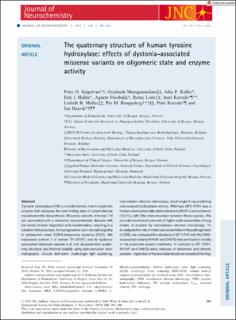| dc.contributor.author | Szigetvari, Peter Daniel | |
| dc.contributor.author | Muruganandam, Gopinath | |
| dc.contributor.author | Kallio, Juha | |
| dc.contributor.author | Hallin, Erik Ingmar | |
| dc.contributor.author | Fossbakk, Agnete | |
| dc.contributor.author | Loris, Remy | |
| dc.contributor.author | Kursula, Inari | |
| dc.contributor.author | Møller, Lisbeth Birk | |
| dc.contributor.author | Knappskog, Per | |
| dc.contributor.author | Kursula, Petri | |
| dc.contributor.author | Haavik, Jan | |
| dc.date.accessioned | 2024-02-09T10:41:04Z | |
| dc.date.available | 2024-02-09T10:41:04Z | |
| dc.date.created | 2019-01-04T11:39:45Z | |
| dc.date.issued | 2019 | |
| dc.identifier.issn | 0022-3042 | |
| dc.identifier.uri | https://hdl.handle.net/11250/3116580 | |
| dc.description.abstract | Tyrosine hydroxylase (TH) is a multi-domain, homo-oligomeric enzyme that catalyses the rate-limiting step of catecholamine neurotransmitter biosynthesis. Missense variants of human TH are associated with a recessive neurometabolic disease with low levels of brain dopamine and noradrenaline, resulting in a variable clinical picture, from progressive brain encephalopathy to adolescent onset DOPA-responsive dystonia (DRD). We expressed isoform 1 of human TH (hTH1) and its dystonia-associated missense variants in E. coli, analysed their quaternary structure and thermal stability using size-exclusion chromatography, circular dichroism, multi-angle light scattering, transmission electron microscopy, small-angle X-ray scattering and assayed hydroxylase activity. Wild-type (WT) hTH1 was a mixture of enzymatically stable tetramers (85.6%) and octamers (14.4%), with little interconversion between these species. We also observed small amounts of higher order assemblies of long chains of enzyme by transmission electron microscopy. To investigate the role of molecular assemblies in the pathogenesis of DRD, we compared the structure of WT hTH1 with the DRD-associated variants R410P and D467G that are found in vicinity of the predicted subunit interfaces. In contrast to WT hTH1, R410P and D467G were mixtures of tetrameric and dimeric species. Inspection of the available structures revealed that Arg-410 and Asp-467 are important for maintaining the stability and oligomeric structure of TH. Disruption of the normal quaternary enzyme structure by missense variants is a new molecular mechanism that may explain the loss of TH enzymatic activity in DRD. Unstable missense variants could be targets for pharmacological intervention in DRD, aimed to re-establish the normal oligomeric state of TH. | en_US |
| dc.language.iso | eng | en_US |
| dc.publisher | Wiley | en_US |
| dc.rights | Navngivelse 4.0 Internasjonal | * |
| dc.rights.uri | http://creativecommons.org/licenses/by/4.0/deed.no | * |
| dc.title | The quaternary structure of human tyrosine hydroxylase: effects of dystonia‐associated missense variants on oligomeric state and enzyme activity | en_US |
| dc.type | Journal article | en_US |
| dc.type | Peer reviewed | en_US |
| dc.description.version | publishedVersion | en_US |
| dc.rights.holder | Copyright 2018 the authors | en_US |
| cristin.ispublished | true | |
| cristin.fulltext | original | |
| cristin.qualitycode | 2 | |
| dc.identifier.doi | 10.1111/jnc.14624 | |
| dc.identifier.cristin | 1650305 | |
| dc.source.journal | Journal of Neurochemistry | en_US |
| dc.source.pagenumber | 291-306 | en_US |
| dc.identifier.citation | Journal of Neurochemistry. 2019, 148 (2), 291-306. | en_US |
| dc.source.volume | 148 | en_US |
| dc.source.issue | 2 | en_US |

